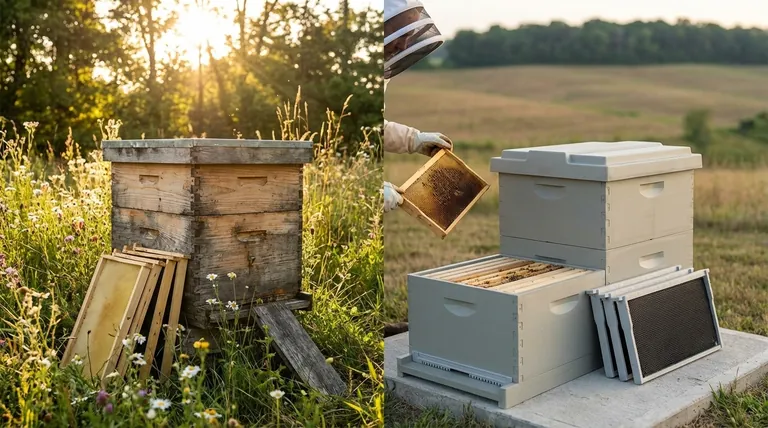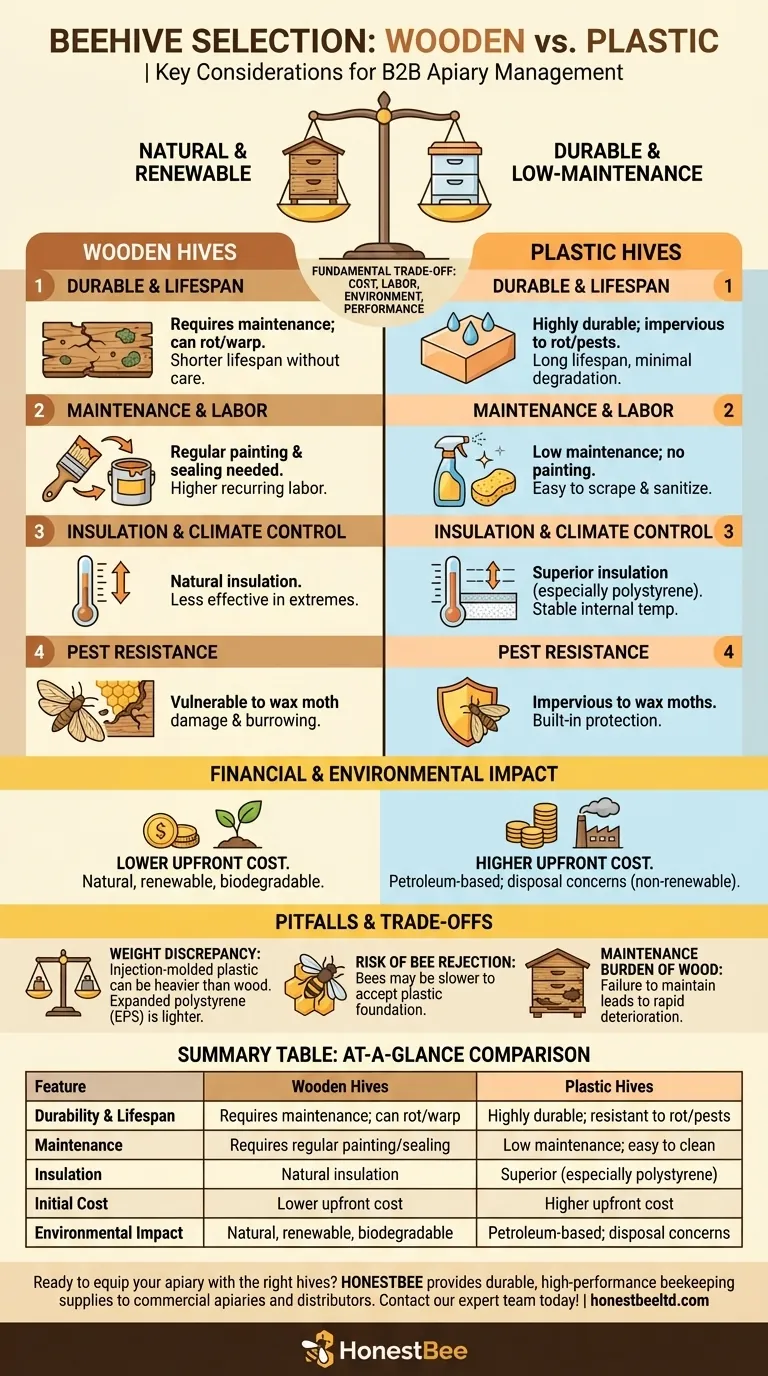The primary considerations when choosing between wooden and plastic beehives center on a fundamental trade-off: the natural, renewable qualities of wood versus the durability and low-maintenance convenience of plastic. Your decision will be shaped by your priorities regarding initial cost, long-term labor, environmental impact, and hive performance in your specific climate.
Choosing a hive material is not about finding the single "best" option, but about aligning your equipment with your personal beekeeping philosophy and practical goals. The right choice balances initial investment against long-term durability and maintenance workload.

The Core Comparison: Wood vs. Plastic
Understanding the key differences in performance and upkeep is the first step in making an informed decision. Each material brings distinct advantages to the apiary.
Durability and Lifespan
Plastic hives are fundamentally more durable than wooden hives. They are impervious to rot and will not warp or split when exposed to moisture and changing weather.
This inherent resistance gives them a significantly longer lifespan with minimal degradation over time. Wood, by contrast, will eventually break down and requires more careful handling.
Maintenance and Labor
Plastic offers a significant reduction in maintenance. These hives do not require painting or sealing to protect them from the elements. Cleaning is also simpler, as surfaces can be easily scraped and sanitized.
Wooden hives demand regular upkeep. They must be painted or sealed before use and periodically thereafter to prevent moisture damage and rot, representing a recurring labor cost.
Insulation and Climate Control
Polystyrene, a specific type of plastic, provides superior insulation. This helps bees maintain a stable internal hive temperature, using less energy to stay warm in the winter and cool in the summer.
Traditional wooden hives offer some natural insulation but are generally less effective than polystyrene. This can be a critical factor for beekeepers in climates with extreme temperatures.
Pest Resistance
Plastic is impervious to pests like wax moths. These destructive pests cannot chew through the material, offering a built-in layer of protection for your comb and bees.
Wooden hives are vulnerable to wax moth damage, as the pests can burrow into the wood itself, creating places to hide and lay eggs.
Understanding the Financial and Environmental Costs
Beyond the physical properties, the initial cost and long-term environmental footprint are critical factors that influence the decision for many beekeepers.
Initial Investment vs. Long-Term Value
Wood is typically less expensive to purchase upfront. For a beekeeper starting several hives, this can represent a significant initial saving.
While plastic hives often have a higher initial cost, their durability and lack of replacement needs can make them more cost-effective over the long run.
Environmental Impact
Wood is a natural and renewable resource. Wooden hives can be repaired, and at the end of their life, they are biodegradable.
Plastic is a non-renewable, petroleum-based product. While extremely long-lasting, disposal can be an environmental concern as many types are not easily recyclable.
Pitfalls and Practical Trade-offs
No material is perfect. Acknowledging the downsides of each option is crucial for avoiding frustration and aligning the equipment with your expectations.
The Weight Discrepancy
The weight difference depends entirely on the type of material. A hive made of high-density, injection-molded plastic can be heavier than a standard pine hive.
However, hives made from expanded polystyrene (EPS) are significantly lighter than wood, making them much easier to lift and manage.
The Risk of Bee Rejection
While uncommon, bees may be slower to accept plastic components. Some beekeepers find that bees are more reluctant to draw out comb on plastic foundation compared to natural beeswax foundation often used in wooden frames.
The Maintenance Burden of Wood
The "natural" appeal of wood comes with a commitment. Failure to properly maintain a wooden hive by painting and sealing it will lead to rapid deterioration, negating its value and potentially harming the colony.
Making the Right Choice for Your Apiary
Ultimately, the best hive material is the one that best suits your goals, budget, and beekeeping style.
- If your primary focus is a natural approach and minimal upfront cost: Wood is the traditional and most effective choice for your needs.
- If your primary focus is long-term durability and low maintenance: Plastic provides a clear advantage, saving you significant time and labor over many seasons.
- If your primary focus is hive performance in an extreme climate: High-density polystyrene hives offer superior insulation that helps regulate hive temperature.
Choosing your equipment is the first step in a long and rewarding journey, so select the material that best supports your vision for your apiary.
Summary Table:
| Feature | Wooden Hives | Plastic Hives |
|---|---|---|
| Durability & Lifespan | Requires maintenance; can rot/warp | Highly durable; resistant to rot/pests |
| Maintenance | Requires regular painting/sealing | Low maintenance; easy to clean |
| Insulation | Natural insulation | Superior (especially polystyrene) |
| Initial Cost | Lower upfront cost | Higher upfront cost |
| Environmental Impact | Natural, renewable, biodegradable | Petroleum-based; disposal concerns |
Ready to equip your apiary with the right hives?
At HONESTBEE, we supply durable, high-performance beekeeping supplies and equipment to commercial apiaries and distributors through our wholesale-focused operations. Whether you prioritize the natural appeal of wood or the long-lasting efficiency of plastic, we provide the reliable equipment you need to support your colonies and your business.
Contact our expert team today to discuss your hive requirements and get a wholesale quote!
Visual Guide

Related Products
- Assembled Wooden Bee Frames with Plastic Foundation for Durability and Convenience by HONESTBEE
- Plastic Bee Frame Beekeeping Hive Frames for Wholesale
- Yellow Plastic Bucket Pail Perch for Beekeeping
- Assembled Wooden Bee Frames with Beeswax Foundation Ready to Use by HONESTBEE
- 4 Frame Plastic Nuc Boxes for Beekeeping Bee Nuc Box
People Also Ask
- How should you dry bee frames after cleaning? Prevent Warping and Ensure Hive Health
- Can old bee frames be reused? Weighing the Risks vs. Rewards for Your Hive
- Can I reuse old frames? A practical guide to saving money and reducing waste
- Can beekeepers switch between wooden and plastic frames? Optimize Your Hive's Performance
- What materials are commonly used for beehive frames? Wood vs. Plastic for Your Apiary



















